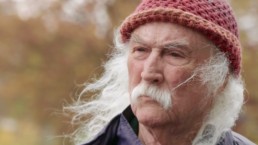Crosby Faces the Music in ‘David Crosby: Remember My Name’
This is a custom heading element.
DAVID CROSBY: REMEMBER MY NAME (2019)
Directed by: A.J. Eaton
Distributed by: Sony Pictures Classics. 95 minutes. Opens July 19 at ArcLight Hollywood and The Landmark.
How is David Crosby still alive? The mystery of how the singer has conquered drug addiction, multiple health scares, jail time, and heartbreak will undoubtedly draw fans to David Crosby: Remember My Name. But if you’re expecting drama and trauma, you may want to look elsewhere.
Confronting his mortality, Crosby, 77 – previously part of two supergroups The Byrds and Crosby, Stills & Nash (and sometimes Young) – is here to make peace and offer something of a mea culpa.
Director A.J. Eaton’s documentary opens with Crosby sprawled on the couch, therapy-style, humorously recounting a drug-addled encounter with legendary jazz musician John Coltrane in the bathroom at one of the saxophonist’s gigs. But Crosby isn’t here to dish about his famous friends: instead, he focuses on making amends to his family, both biological and musical.
On the receiving end of Crosby’s warts-and-all confessions is Almost Famous writer, director, and rock journalist Cameron Crowe, who was drafted by Eaton to coax the talkative Crosby into baring his soul. There is a lot to cover besides Crosby’s rock ‘n roll stardom, including his arrest on weapons and drug charges in the 1980s, and his 32-year marriage to adoring wife Jan Dance, also a recovering addict.
One foot in the past and the other in the present, the time not with Crowe is spent on a road trip, with Crosby driving to pivotal places along his musical superhighway. These include stops on the Sunset Strip, a reluctant trip up Laurel Canyon, and to Kent State, Ohio. These reflections are interwoven with footage of a recent solo tour, where we see that Crosby is still in fine form musically, despite a myriad of health problems, including a heart condition, diabetes, and other maladies.
Although the source of his addiction isn’t analyzed in-depth, one trigger apparently was the death of lover Christine Hinton, killed in a car accident in 1969, the same year CSN&Y recorded their top-selling record Deja Vu. While Crosby laments the toll losing Hinton had on him, his regrets the fact that he is no longer on speaking terms with many of his former bandmates, including his main musical partner Graham Nash. Why, we’re not exactly sure, but Nash and Young are heard saying that they were no longer able to tolerate Crosby’s words and behavior.
Despite all the fertile material, Remember My Name may disappoint some by what’s omitted: Major life events don’t even garner a mention, including Crosby’s liver transplant in 1994—which occurred within months of his reuniting with a son who was given up for adoption 32 years prior. Crosby also served as the sperm donor for singer Melissa Etheridge, resulting in two more children. Crosby’s complicated family tree could be a movie itself.
At the film’s end, you’re left to decide how you feel about Crosby and whether he’s sufficiently made amends. Indeed, of all the recent music films that came out this year capturing the 1970s musical landscape—from Amazing Grace to Rolling Thunder Revue: A Bob Dylan Story and Echo in the Canyon —the one which Remember My Name shares a common lineage is, bear with me, the over-the-top biopic Rocketman. Crosby and Elton John burned bright in the 1970s and went down strikingly similar paths: Both speak of their loveless fathers and find solace and redemption through music. Both men achieve massive stardom and succumb to drug addiction before coming out the other side.
These films ask us to either empathize with or at the very least better tolerate the havoc their subjects wreaked (on themselves and others.) Whereas Rocketman concludes with a montage of John’s triumphs since sobriety, we’re just grateful at the end of Remember My Name that Crosby is alive to sing another day. That, the filmmakers seem to say, is enough.
Jane Greenstein
Jane Greenstein is a Los Angeles-based digital content strategist and freelance writer, covering arts and culture. Read more of her writing here: http://www.janegreenstein.com/blog/

